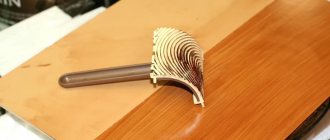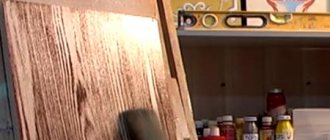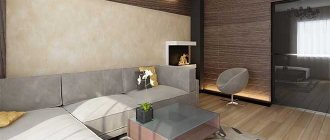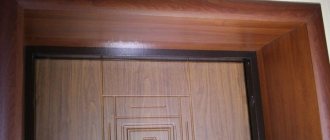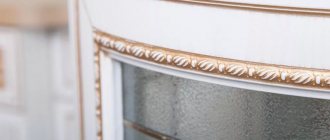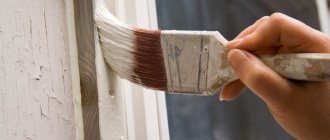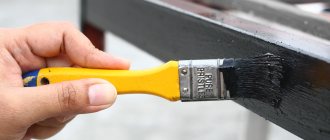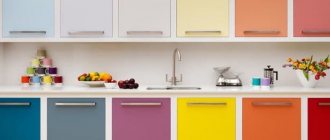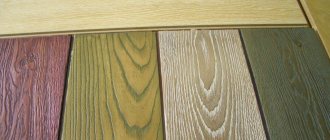Wood is a material that easily fits into any environment. Therefore, when planning to update any piece of furniture, they often choose a color that imitates this natural material. But not everyone knows how to paint this or that surface with their own hands to look like wood. I suggest you understand the nuances of the technique, get acquainted with different decoration options and the features of choosing paint.
Source sargorstroy.ru
What is disguised as a tree?
Imitation of a wooden surface is relevant for many materials; the characteristic texture is reproduced on metal, plastic, ceramics, glass, chipboard and MDF. I would like to note that technologically there is not much difference on what basis the desired pattern is created. Different textures are obtained by mixing different colors and using additional tools.
Most often furniture, doors and windows are treated as wood. Sometimes it is necessary to make auxiliary metal products aesthetically attractive, for example, corners, load-bearing structures, shelving shelves, joints of different flooring materials, metal thresholds used to seal joints when laying laminate or boards.
Imitation wood can add a stylish look to your car's interior, dashboard or doors. With the correct selection of dyes, they create the texture of different types of natural wood (oak, ash), imitation of bark, roughly processed or polished boards.
Source journal.homemania.ru
Choosing paint
When choosing paints and varnishes, the first thing you need to focus on is the nature of the surface on which the effect of natural wood will be created. The dye should match the type of substrate, but in most cases, water-based acrylic is the best choice. Its consistency is ideal for brush work.
It is equally important to determine the colors (you need two of them) that represent the shades of the wood as realistically as possible. They try to choose the combination so that the surface appears to be made of a certain type of wood. You will need a light tone (shades of beige, golden, light gray, sand) and dark (dark brown, black, burgundy). Also remember the following rules:
- Buy paints from one manufacturer.
- The shades are applied in layers: first light, then dark. Therefore, the dark composition should be more liquid; this will make it easier to spread over the bottom layer.
Source materialexpert.ru
- The colors should form a natural combination and suit each other. Too much contrast will look unnatural.
- When choosing, consider the palette of the interior, furniture or decoration. This will help fit the updated item into the decor.
Coloring materials
The paint for the door should be chosen based on the room it is intended for. For example, it is better to finish the entrance to the bathroom with the most moisture-resistant composition, and to the children's room - easy to clean and resistant to abrasion.
In addition, paints vary in quality and price. The most affordable ones are oil and alkyd enamels, but it is better to work with them in the fresh air, since their sharp unpleasant odor does not disappear from the room for a very long time. Acrylic-based materials are the most popular, they are easy to work with, they are non-toxic, dry quickly and have excellent technical characteristics.
On the finishing materials market today you can purchase special wood-like paints that imitate the appearance of noble and expensive species, as well as compositions designed specifically for the restoration of old surfaces. Many of them have excellent protective properties, preventing mold and cracking, while allowing the wood to “breathe.”
Attention: when calculating paint consumption, do not forget to take into account the door jambs and lintel! If you are tinting the composition yourself, creating a complex shade, take care of a supply of solution, since it is almost impossible to repeat the tone by mixing an additional portion.
When choosing a color scheme, and especially a complex combination of shades, it is not difficult to make a mistake. To prevent this from happening, experiment with gouache on a sheet of whatman paper. Apply at least an approximate base color, on top - the expected light tone, brush with a stiff brush and admire.
Try several options, decide on your choice and feel free to go to the construction market. Now you know how to paint doors to look like wood with your own hands.
Painting wooden structures
Wood-like painting of a wooden base is carried out if restoration work is necessary. Over time, its appearance is lost and it is necessary to update it. The second reason is a change in the tone of the product.
The technology for painting wood is the same as for other materials, the surface of which imitates its structure:
- The old covering layer is removed with a spatula.
- The surface is coated with a special primer or drying oil.
- The paint is replaced with clear varnish.
- Before painting to resemble wood, the surface of the base is treated with a brush with stiff bristles. This way you can achieve a resemblance to a natural pattern.
Painting it with your own hands gives it a new look. The CM is applied along the fibers of the natural base. The movement of the hand is not interrupted. Areas where contact with moisture or exposure to the sun's UV rays are expected are carefully painted. The more layers you apply, the longer it will last. This increases the gloss of the tone.
Pre-treatment with a primer reduces dye consumption. The paint layer clings more to the wooden base.
Powder coating technology is used in the manufacture of furniture, windows, and doors.
Alkyd enamel
A fairly common option that has a rich color palette. Preference should be given exclusively to compounds labeled for interior use. A distinctive feature of the material is its low cost. It is this factor that explains the popularity of alkyd enamel.
Alkyd enamel - a finish accessible to everyone
There is one negative point. It lies in the fact that the paint has a very pungent odor. It should be borne in mind that this unpleasant moment persists even after the coating has dried. This feature makes it difficult to use the material.
Working with wood surfaces
At first glance, it may seem that such a formulation of the building will sound strange, because it is required to paint the wooden surface to resemble wood. But in practice, in the process of repair work, sometimes it will be necessary to paint the wood to look like wood. This procedure is important when, over the years, the wood has lost its attractive appearance and needs restoration. Staining is also carried out to change the tones of products and wooden coverings. The process of processing materials is almost no different from painting other materials that imitate natural wood.
When painting wood, the following actions should be taken:
- A clean surface should be sanded or coated with a special primer.
- Instead of a paint coating, you can use clear varnish.
- Before you start painting, you should treat the surface with a stiff brush, which will make it possible to achieve a perfect resemblance to the real material.
We recommend: Arrangement of lamps on a suspended ceiling (42 photo options)
Remains of old paint can be removed with a spatula during the preparatory stage. The powder coating method will be even more popular these days. One industry that uses this technique is wood decorating. Such coloring will be extremely important when creating products in the form of pieces of furniture.
Please note that this method is used when painting windows, doors, office partitions and other wooden products. You should also decorate other materials that are used as fasteners.
Painting the doors to look like wood yourself will give an old product a new and high-quality look.
Wood putty
Putties compatible with coatings made from wood materials include the following materials:
- Gypsum based (cheap in cost and therefore popular).
- Acrylic (expensive in price, but high quality).
- Polymer-based (not cheap, but well compatible with wood).
- Nitro compounds (have a pungent odor, but are harmless when applied).
- Oil (have excellent protective properties).
- Adhesive based (made using PVA).
Protective impregnations for wood
Antiseptics. These are impregnations that protect wood from the growth of fungi and mold and stop wood rotting.
Insecticides. Provide tree protection from attacks by pests and rodents
Fire retardants. Protecting wood from fire. Of course, no impregnation will save you 100% from a fire. But fire retardants reduce the flammability of wood, that is, the material resists fire longer. The flame does not spread as quickly. There is additional time to localize the fire. Water-repellent impregnations. One of the dangerous enemies of wood is moisture. Exposure to moisture destroys wood. The material is deformed, mold and fungi appear
It is important to protect the tree as much as possible from moisture and humidity changes.
Combined and one-component impregnations
Protective impregnations for wood on the market can be combined or single-component. Single-component ones are aimed at protecting against a specific negative impact. Combined ones provide comprehensive protection.
How to choose a dye
You need to choose enamel taking into account the nature of the surface on which it will be applied. It is necessary to choose suitable colors to make the imitation of wood with paints more realistic.
You will have to choose 2 tones:
- light (beige, sand, light shades of yellow are suitable);
- dark (dark shades of brown, burgundy, black).
Color combinations are selected so that the product looks like it is made from a particular type of wood. Both dyes must be made by the same manufacturer. In addition, you should select a thinner dark paint: it is applied on top of the light one.
You should not choose colors that are too different from each other: due to the sharp contrast, the color will turn out unnatural. It is recommended to take into account the colors of existing furniture or decorative elements so that the color of the new item matches the overall solution.
Paints
Wood paints are consistently popular. They allow you to renew the surface, but hide the natural texture. If the technology is followed, the result is a coating that is distinguished by individuality and a magnificent decorative effect.
The following compositions can be used in the work:
- Oily. This variety is currently used quite rarely. This is due to the many negative qualities that the mixture has. Among them, the sharp and toxic odor, as well as the long drying time, stand out. The composition is used for painting wooden bases and household products.
The advantages of oil paint include good adhesion and high covering power.
- Alkyd enamels. This option, like the previous one, has become less popular, but demand remains at a good level. This is because the mixture is excellent for outdoor woodwork. After application, a thin film is formed on the surface, thanks to which it is possible to emphasize the texture of the base. In addition, enamel has low vapor permeability, which reduces the risk of wood deformation when exposed to moisture. They are not durable.
Alkyd compounds are best used for outdoor use as they have a toxic odor
- Water-based (water-dispersed):
- Acrylic. The basis of such solutions is water and acrylic resins; they also contain additional modifiers. Due to this, the mixture turns out to be completely environmentally friendly. The scope of application is wide: it can be internal and external surfaces and even furniture. Possessing elasticity, the material prevents the appearance of cracks and damage to the wood.
Acrylic water-based coating is an environmentally friendly, fireproof type of coating with good adhesion
Latex. Hides surface cracks up to 1 mm wide, a good option for protecting the coating from the harmful effects of moisture.
Compared to acrylic paints, latex paints are more moisture resistant
On a note! Acrylic solutions may additionally contain a latex-based additive, which increases the water-repellent properties of the material. In addition, PVA water-based emulsion is available, but it is better not to use it for working with wood.
Epoxy coatings are highly durable and resistant to abrasion, as well as various chemicals and solvents.
Thus, to the question: is it possible to paint wood with water-based paint, the answer will be in the affirmative. These products are considered the most preferable. It not only has excellent characteristics, but is also well tinted, which allows you to realize your design imagination.
Lucky
Wooden products can also be painted with varnishes. They can be transparent or with tinted properties. Suitable media for this material are:
- With polyurethane, a popular type, the drying process takes little time, but it contains a thinner, so it emits an unpleasant odor;
- Water-based, can be used both inside and outside the building, requires a priming step, drying takes up to a day;
- Acrylic, has a pleasant appearance and good characteristics. However, its cost is high;
- Nitrovarnish, used for working with budget furniture, low lightfastness.
We can use it as a single material or as a coating on top of paint. In this case, it is necessary to correctly select it for a specific coloring composition.
Varnishes can be transparent or with tint properties.
Acrylic
What paint to paint a wooden house if it needs to be done quickly, the cost of the work is not of primary importance, and great attention should be paid to the quality of the painting? In this case, acrylic compositions are best suited for facade work and exterior decoration of buildings. Wooden buildings go quite well with acrylic coatings; moreover, acrylic as a dye base is used for finishing not only the outside of the house, but is also well suited for interior decorative and finishing work
Wooden buildings go quite well with acrylic coatings; moreover, acrylic as a dye base is used for finishing not only the outside of the house, but is also well suited for interior decorative and finishing work.
The service life of acrylic paint on the facade of a house is 8 years.
Acrylic compositions, being quite universal in purpose, are suitable for painting any surfaces, and not just wood. In this case, wooden houses with existing metal or brick structures would be best painted with acrylic substances.
The external beauty of finished surfaces is one of the most important advantages of acrylic. What makes it different from oil is that it allows air to circulate through it so the walls can breathe, which makes it advantageous over other types of paint. It is also worth considering that acrylic dyes, as a rule, last up to 8 years, after which they can be renewed if necessary.
We recommend: Making wooden doors: technology and production, how to make door leaves and frames with your own hands
Other dye options
These may be the following substances:
- Stain. Allows you to give the wood a richer texture. For example, after treating cheap pine with a properly selected stain, the appearance of noble oak is created. Can act as a protective impregnation.
Today, most manufacturers produce stain in several shades that are as close as possible to the natural color of natural wood. - Potassium permanganate. The solution is prepared in the proportion of 50 g of manganese per 1 liter of warm water. The mixture is well treated with the base, if necessary in several layers. If you paint the floors with this composition, they will look like dark walnut.
Regardless of the material chosen, the surface is coated with colorless varnish.
Paint application technology
Work must be carried out in compliance with the temperature and humidity levels required for applying a specific type of paint. To prevent the paint from peeling off over time, do the following:
- Start painting from the corners;
- Alkyd and oil compositions are painted vertically, acrylics horizontally;
- Three layers are made, for the first a more liquid product is used, for this purpose it is diluted, the second is needed to hide defects, it can be processed with sandpaper, the final one should be applied after the second has completely dried;
- If the tool chosen is a spray gun, then hold it at a distance of 25 centimeters and apply the paint in horizontal stripes.
Alkyd and oil compositions are painted vertically, acrylics horizontally.
The article described how to paint or varnish wood at home. The coloring agent is selected based on the required properties and the estimate for the work. Careful preparatory work is important; if you do everything step by step, it will not be difficult to get the desired result.
What tools are needed
Any paint and varnish composition is applied to the prepared surface, and for preparation you will need the following tools:
- Screwdrivers. You cannot do without them if there are parts on things that you do not plan to paint (for example, handles on the facade or on doors).
- Devices for cleaning: sandpaper of various grains, wire brushes, metal sponges.
In the process of applying “wooden” decor, the following items are used:
- Painting tool. Depending on your preferences and the amount of work, this could be a set of brushes, a roller with a removable attachment, or a spray gun.
Source okuzove.ru
- Paint and varnish products. Paint in two shades (possibly aerosol), primer, transparent (colorless) varnish.
- For some types of decoration, additional tools are needed, for example, a trowel for plastering work (with a rubber sponge).
How to prepare a surface for painting
The following procedure is suitable for all types of surfaces (with some adjustments):
- All small parts that may interfere with the work are removed and they are not planned to be painted. Everything that cannot be dismantled and cannot be painted is carefully packaged in masking tape.
- The field of activity is cleaned of dirt and old finishes (if any), and then leveled using sandpaper with different grain sizes (first coarse, then fine). If the area allows and you have the skill, it is more convenient to use a grinding machine.
Source gotrangtri.vn
- The previous point is skipped if plastic is being prepared for painting. It is better to leave it rough to increase adhesion (adhesion to paint). This is where a wire brush comes in handy.
- Metal products are checked for rust (corrosion). If it is detected, the affected area is cleaned and treated with a rust remover.
- Using putty, fill unevenness and defects; After drying, sand it again.
- The surface is degreased using acetone and white spirit. For metal, an alkaline agent is suitable; for plastic, the best choice is an antistatic agent (you can use either a spray or a concentrated liquid).
Source kraska.guru
How to clean plastic panels?
found in the kitchen is most susceptible to contamination ; fatty deposits along with dust particles will quickly do their job, and now dirty stains are visible on the surface simulating marble or tiles, which are best removed as often as possible, in which case the work will be less labor-intensive.
For cleaning you can use :
- Kitchen cleaning powders;
- Dishwashing liquid;
- Sponges and soap solution.
Under no circumstances should scrapers, pumice stones or other hard abrasives be used to clean plastic panels, as this will lead to scratches and deterioration of decorative qualities.
Also, you should not use aggressive reagents with a high content of hydrochloric and sulfuric acid for cleaning.
Fat deposits are easily removed with the help of cleaning powder applied to a sponge, and warm water; however, it should not be rubbed with great effort; the plastic surface is quite easy to clean.
Plastic
For anyone who has decided to paint wood-like plastic with their own hands, it is useful to remember the following subtleties:
- For painting it is best to use acrylic or oil paint. But the water-based composition is a bad idea. It is too liquid for such coatings, and will flow even from a properly prepared surface.
- Avoid formulations containing solvent; they can damage the plastic coating. It is also useful to know that not all types of plastic can be painted.
- Preparation of plastic consists of sanding and priming.
- The roller will not be able to properly paint the plastic; use a wide, medium-hard brush.
Source expo-sib.ru
How to paint plastic panels?
For those who do not accept constancy in their decor, paintable coatings have long been invented, so when you get tired of one color, you just need to choose a paint and repaint it , but it is not at all necessary to attribute this property only to wallpaper or drywall.
Plastic panels are also easy to paint.
Of course, not all coloring solutions are suitable for this; you can immediately exclude such popular water-based paints , since they will simply flow off due to lack of adhesion.
Experts recommend using acrylic paints , they are harmless, do not have an unpleasant odor and are easy to clean, but at the same time they can only be applied using a spray.
Since the basis for the production of plastic is hydrocarbons, the paint must have the appropriate composition.
As a simpler and always reliable option - oil paints , of course you will have to wait until the smell disappears, but this coating can be applied using a roller, and everyone knows about its good stability.
Tree
The need to paint a wooden surface “like wood” arises if you want to change the shade or refresh the design on an old item. The process includes the following steps:
- The cleaned and prepared surface is coated with a primer (sometimes drying oil is used).
Source pinimg.com
- Additionally, you can treat the coating with a stiff brush; this will improve the resemblance to natural texture.
- Powder painting technology is preferred. A colorless varnish that is easy to apply by hand has proven itself well.
How to paint metal
Metal products are painted after pre-treatment with a primer. You will have to choose fire retardant paint for metal. If you plan to use a painted item outdoors, you need to choose a dye that prevents corrosion and is electrically protective.
Powder paints are best suited. Powder painting involves the use of special sprayers. They are decorated in a special chamber under high temperatures.
Pay attention to: Technology of painting decorative plaster: choosing paint and color, creating various effects
Methods for simulating natural texture
The most accessible methods are:
- Using a trowel for plastering work (with a rubber sponge imitating a wood pattern) . The easiest option to implement. You apply a layer of light paint and leave it to dry completely. Then apply the dark composition, wait for it to dry a little, and stamp the pattern with a sponge. When everything is dry, cover the decor with two or three layers of varnish.
Source rubankom.com
- Liquid mixing . The method is used to form a pattern on objects with a large area of painting (for example, on doors or furniture facades). The first layer of light paint is slightly dried, after which the second dye is applied with a brush. As a result, the shades blend slightly to create a realistic textured pattern. After drying, the coating is varnished.
- With application of soot . The object is painted and the paint is allowed to dry. Then set fire to a piece of plastic (it is convenient to use a disposable spoon or, for example, a straw). When soot appears, lines are drawn with it, trying to reproduce the wood texture. It is better to choose darker paint, it will look more believable. The resulting pattern is varnished.
Source: amazon.com
About one of the wood decor techniques in the following video:
How to do without special paints
In the photo - drawing the texture by hand
What to do if there are no special compounds to imitate the texture of wood in the nearest hardware stores, and most likely they will not appear, but it is necessary to decorate this or that surface?
In this case, you will have to awaken your creative potential and get to work.
- In order to paint a wooden surface, we will need acrylic paints and varnish on a similar base . We select paints of two colors: one is dark brown, the other is several tones lighter, closer to beige. We also use two types of flat brushes with stiff bristles. One brush with longer bristles and the other with shorter bristles.
- We prepare the surface . We clean it from dirt and dust and prime it if necessary.
- Apply dark paint as the first layer . The layer should be uniform and should be applied with a long-bristled brush. When the first layer is completely dry, you can begin applying the texture.
- Apply light paint as a second layer, also using a long-bristled brush..
In the photo - a tool for simulating wood using simple paints
- Then we wait until the second layer begins to dry, take a short-bristled brush and draw one line across the coating from side to side . Veins resembling wood fibers will appear on the surface of the painted coating.
Tip: If the brush is not hard enough, you can use a clothes brush to apply texture.
- After the second coat of paint has completely dried, you can apply varnish..
